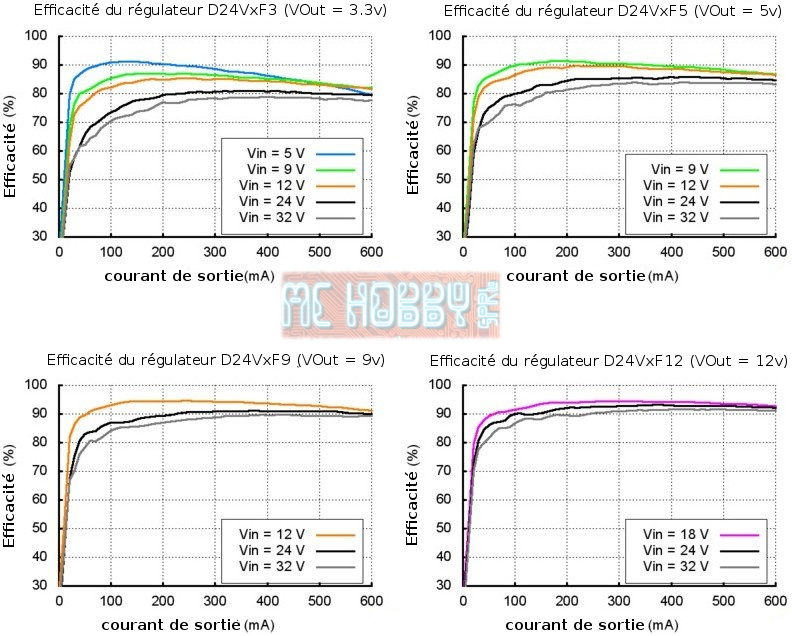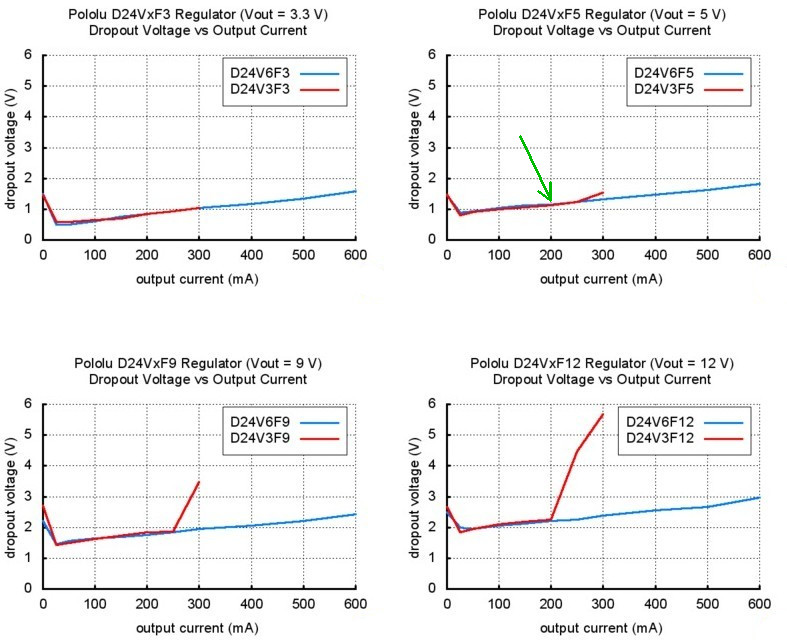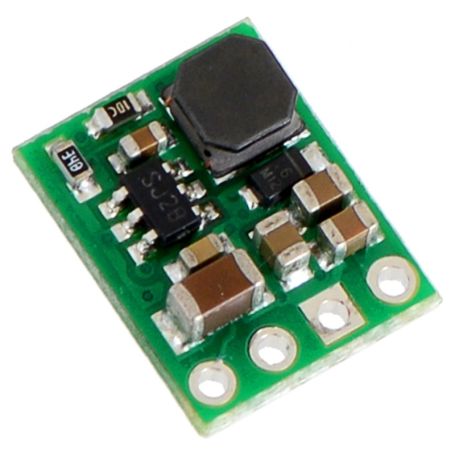5V 600mA regulator, Step Down, D24V6F5
Switching regulator D24V6F5
- 5V
- 600mA
- Step-Down
Payments are secured by LyraCollect, a French payment collection company.
It is possible to delivered to your home, to a pick-up point or picked up by appointment at MCHobby
We prepare, pack and ship your orders with great respect and care.
Effectively reduce the voltage at 5V with this DC-DC regulator
The switching voltage regulator D24V6Fx step-down produces a voltage of 5V from a power source between 7V and 42V. These switching regulators are commonly called DC-to-DC regulator, Switched Mode Power Supply (SMPS) or switching regulator.
This regulator has an efficiency between 80% and 90% and is more efficient than a linear voltage regulator... especially since the voltage difference between the input and output is large.
The regulator has a protection against short-circuits and a thermal safety protecting the circuit against overheating (by breaking). The card DOES NOT have reverse polarization protection.
Step-up, Step-Down... What about it?
(Step-Up is an English term that we will translate as "increase". While Step-Down will be translated as "diminish".)
These are characteristics of switching regulators. A Step-up regulator is able to increase the voltage to reach the desired voltage. A Step-Down regulator will be able to handle a higher voltage input to reach the desired voltage.
A Step-Up/Step-Down regulator is able to reach the desired voltage from a lower or higher supply voltage. The latter model is useful if you need to keep a project running for as long as possible with a power source whose voltage drops over time (ex: battery).
Characteristics
- Input voltage: [output voltage + Drop-Out voltage] up to 42 V
The Drop Out voltage is the voltage loss caused by the regulator. To see further.
- Output : fixed to 5V accuracy of +4%
- Output current: 600mA
- Hash frequency: 1.25 MHz
- Protection against overheating (by breaking) and short-circuits.
- Standby current of 2mA (typical when there is no charge).
Can be reduced to 20µA if the nSHDN pin is set low. - Size: 13 × 10 × 3 mm
Use the regulator
During the operation of the regulator, the temperature may become high enough to burn you. Be careful when handling this product and those connected to it.
Connection
The regulator has 4 denominated connections on the back of the card:
- VIN: input voltage.
- GND: the ground.
- VOUT: output voltage.
- nSHDN: (reverse logic) Shutdown is used to switch the card to save power.
The connections have an impaction of 2.54mm, which is ideal for using the card with breadboards and prototyping card. Thanks to the connectors supplied with the card, you can weld the regulator against the card or perpendicularly (to save space).
nSHDN: The nSHDN pin can be set low (below 0.3V) to disable the output and place the card in a power saving mode that typically consumes 20µA. It can be set high (above 2.3V) to activate the card. You do not have to use this feature and can connect the nSHDN pin directly to VIN to activate the card as soon as it is turned on. Do not leave this pin disconnected to avoid unpredictable operation.
VIN: The input voltage must be greater than VOUT + the voltage drop-out (voltage drop of the regulator, see the graph of the voltage drop-out depending on the charge). Make sure that the noise on your input pin does not exceed the maximum of 42V. Also be careful with the over-voltage peaks of LC circuits (see note).
VOUT: The output voltage is set by the regulator model. The D24VxF3 version produces 3.3V output, the D24VxF5 version produces 5V, the D24VxF9 version produces 9V and the D24VxF12 version produces 12V.
The input voltage must be between 2.7V and 11.8V. A lower input voltage cuts the regulator while a voltage higher than 11.8V can destroy it. You must also avoid excessive noise and stay attentive for destructive voltage peaks that may be caused by LC circuits.
Efficiency and output current
The efficiency of the voltage regulator is defined as "output power" / "input power". This is an important measure of performance, especially if battery life or heat generation are critical to your projects. As shown in the graph below, this regulator has an efficiency between 85% and 95%. The power saving characteristics make it possible to maintain this very high efficiency even when the current is very low.

The maximum current that can be obtained from the card depends on the regulator model. You will not be able to get more than 300mA from the 300mA regulator and 600mA for the 600mA regulator.
Typical voltage drop (Drop-out voltage)
The voltage drop of a Step-Down regulator is the minimum amount of voltage that must be added to the VIN input. This voltage drop is also called Drop-Out voltage.
See the green arrow in the graphs below. If you use a 5V regulator: the input voltage must be at least 5V + 1.1V (6.1V) for a D24VxF5 (5V output) delivering a current of 200mA.

You can see on the last two graphs that the 300mA regulators (9 and 12 V) have a drop-out voltage which really becomes very important when we approaches the 300mA. On the other hand, the 600mA version of the same regulator (blue curve) has a much better controlled voltage drop and remains more stable
Over-voltage spikes caused by LC circuits
When you connect the voltage to an electronic circuit, the initial current draw can cause an over-voltage spikes that can be much higher than de input voltage. The regulator may be destroyed if these over-voltage spikes exceed the maximum permitted voltages. If you are using connection wires of about 50cm and connect a power supply of about 20V then you could get over-voltages per LC circuit that can exceed 42V. If you are using a power supply of more than 20V or a high inductance power supply, we recommend welding a capacity of 33µF or large electrolytic capacity near the regulator between VIN and GND. The capacity must be able to support a voltage of at least 50V.
More information on LC over-voltages can be found in the pololu application notes, see "Understanding Destructive LC Voltage Spikes".













